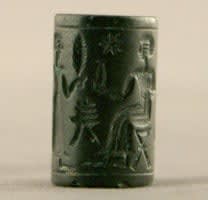Cylinder Seal, 2000 BCE - 1200 BCE
Stone
0.625
CK.0198
Further images
Cylinder seals are characteristic artifacts of ancient Mesopotamian civilization and are considered some of their finest artistic achievements. The seals first appear during the Protoliterate Period (around 3400–2900 B.C.), and,...
Cylinder seals are characteristic artifacts of ancient Mesopotamian civilization and are considered some of their finest artistic achievements. The seals first appear during the Protoliterate Period (around 3400–2900 B.C.), and, although the earliest examples were engraved with primarily geometric, magical, or animal patterns, later seals incorporated the owner's name and depicted a variety of motifs. Sometimes the elements were arranged in symmetrical, decorative patterns; often, however, an action was represented. Cylinder seals were employed in marking personal property and in making documents legally binding by rolling the seal across wet clay, thereby marking the unique “signature” engraved on the cylinder. Their fashioning and use were adopted by surrounding civilizations, such as those of Egypt and the Indus valley.
This seal depicts a standing figure making an offering to an enthroned figure, likely a ruler or deity, flanked by an attandent. Other various symbols fill the spaces in between.
This seal depicts a standing figure making an offering to an enthroned figure, likely a ruler or deity, flanked by an attandent. Other various symbols fill the spaces in between.







